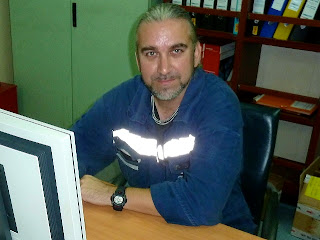“I can recall, forty years ago (in the 1920s), the inferno of a ... boiler-room, the heat, the roar, the half-naked sweating stokers … shovelling coal into the red mouths of the open boilers … You emerged gasping for air. It was like coming out of hell …” (The Grand Cruise Cecil Roberts 1963)
________________________________________________________________
I've been in Amber's engine room before, but just had an extended visit. This was delayed until the North Pacific; in the Middle East, it was stiflingly hot, but, unlike an engine room of the Twenties, there's a pleasantly cool - and quiet - control room and office. Electrician Milan Cojic looks up from his desktop or was it Auto Klub magazine?

This is a power on a grand scale, a propulsion cathedral. From top to bottom, the engine room is about 30 metres (a little over 98 feet) high. For people who understand these things, Amber's main engine is an eight cylinder, two stroke MAN B&W 8K98 MC-C. It eats about a hundred tons of fuel a day at roughly $600 a ton.
An American mariner describes it well:
“It is a machine built so large in size it dwarfs any other single moving power plant in the world. Once set in motion, it is a fire breathing monster running almost out of control … The size of this huge, almost living creature makes it possible to move large, deep draft ships through the water at high speed and, hopefully for the owner, at a cheap cost.” (How to Avoid Huge Ships 1983 Captain John W. Trimmer)

Although I am decidedly untechnical, engineer officers and ratings have taught me how much running a ship’s engine depends – not only on dials and gauges – but also on smell, sight, sound and feel. Bruno says it's like a chef judging a meal, an artist a painting, a musician a symphony.


Here, Bruno shouts, is "the mission." Mid-ocean, the shaft does eighty-four revolutions per minute ...

... and disappears under a platform at the stern. You can see how Amber narrows just feet from the 'semi balanced spade' rudder and six blade propeller on the other side of that far bulkhead.

So we go around the world.
Computers and sensors allowing modern engine rooms to be unmanned overnight will never entirely replace human experience and intuition. Listen to a ship’s engines – listen for months at a time – and you gain a new respect for the machinery and those who keep it working.
On the bridge, I mention my "interesting" visit to the engine room The chief mate grumps, "Yah, yah, interesting for about five minutes ... no, maybe one!" and returns to plotting our position.
________________________________________________
A 'special edition' of the ship's occasional newspaper has just arrived in the passenger lounge. Has the resale price of my Gaddafi watch gone up or down? See my posting from November, 2010.





